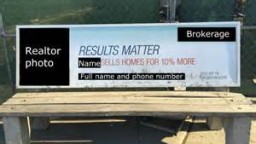Your Face on a Bench: Marketing on Bus Stop Benches
Let’s talk bench ads.
We’ve all seen them – maybe you even have a few of your own. Ads on bus stop benches are one of the most popular – and economical – forms of outdoor advertising, a category that also includes billboards and transit vehicles. Just why, though, would someone want their face superimposed and placed on public furniture that people sit on, lay on, and maybe even sleep on?
Advertising comes in many shapes and forms, and anything that might get you noticed or get someone talking about you is considered a win from a marketing perspective – especially in the hypersocial business of real estate. Most people won’t look twice at the face they’re sitting on as they wait for their bus to arrive, but to the person who happens to be looking for a new house but doesn’t have the first idea of where to start, your smiling mug starts to look very much worthy of a phone call.
The average bench ad in America costs $250 per placement per month. As the entrepreneur website Gaebler puts it, bench ads in a big city might have as many as 25,000 vehicles pass by daily. Annually that works out to over 9,000,000 impressions per year. At $250 per month per bench, you’re paying $3,000 per year for 9,000,000 impressions, which is just over three one-hundreds of a penny per impression. That’s a much better ratio than Facebook or a PPC ad can do for you, and while the impressions you’ll receive from a bench ad are vastly different than those to be found or purchased online, the name of the game is to get your brand and face in as many places as possible.
Bench ads are always on and they easily allow you to target specific areas. With online advertising, there’s a possibility that someone in New York will see your ad when your intended market was really Florida, but by sticking your face on a bench, there’s not a chance in the world that your pearly whites will ever shine on an unintended city.
It’s not all gravy, though. One of the big complaints about advertising on benches is that the commercialization of public property isn’t the best use of a public investment. All of our taxes paid for the bench, so how come Joe Schmo gets to slap his face on it? And if we’re willing to stick ads on benches, what’s next? Will our public streets someday look like the planes of a budget airline, plastered with ads for every imaginable thing?
With outdoor ads making their impression for an average of only 2-3 seconds, bench ads have to be straightforward and direct. Since most real estate ads feature a tagline and the face of a dignified though friendly agent, it’s important to present yourself in the best possible light, and in the least confusing way.
Just because your audience is fleeting, though, doesn’t mean you can’t have fun with the medium. From the Calgary Zoo to Kit-Kat, bench ads have been turned into all kinds of conversation pieces. If a bench ad plays a prominent role in your advertising, thinking outside of the box might very well involve thinking beyond the bench itself.
